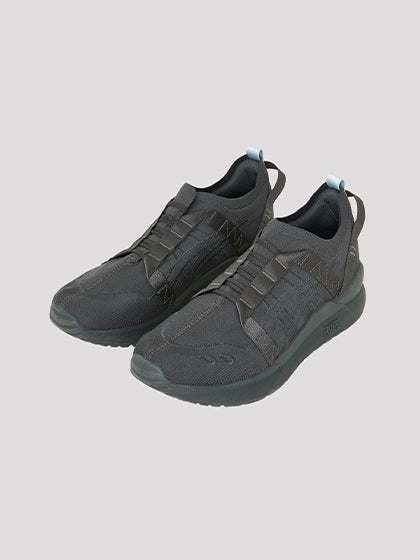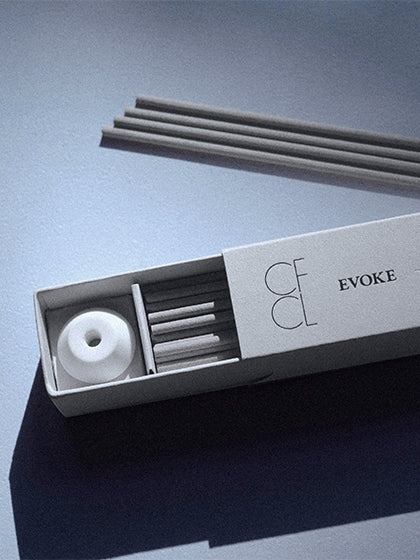
CFCL marked its 5th Anniversary in 2025. From our inception, we have operated on the premise of harmonizing creation and sustainability and conducting business activities that incorporate elements we consider essential for our contemporary era. By not merely expressing individual designers’ aesthetic sensibilities, we integrate these principles into design, mass production processes, and even our management philosophy. Throughout these five years, we have pursued various challenges, including obtaining B Corp certification (2021) and participating in Paris Fashion Week (2022).
This year, we are focused on advancing preparations for B Corp recertification. This process has provided us with an invaluable opportunity to reassess our approach to stakeholder engagement. As CFCL transitions from our founding phase into a growth phase, we remain committed to increasing activities that respond to stakeholder value as we look toward the next decade.
This report focuses on the following three areas:
1. Material Procurement
・Increasing the usage rate of certified materials that ensure responsibility for both the global environment, and the labor conditions of producers
2.LCA (Life Cycle Assessment)
・Verification results for kasuri-dyed recycled polyester products
・Verification results for chusen-dyed silk products
・Verification results for YKK fastener accessories
3.Community Engagement Activities
・Implementation of SPG (SDGs Performance Guidelines) at key partner manufacturing factories
I. Increasing the usage rate of certified materials that ensure responsibility for both the global environment and the labor conditions of producers
*Figure 1: Material Usage Ratio in VOL.9 Collection (1*)

*Fittings and accessories such as buttons, zippers, ties, waist elastic, etc. are not included in this total.
CFCL actively promotes the use of materials certified for environmental responsibility and fundamental human rights from the raw material stage. In the VOL.9 collection, 91.91% of materials used were certified, marking a 1.39 percentage point increase from the previous Spring/Summer VOL.7 collection (90.52%). This improvement was achieved by reducing the use of non-certified materials such as virgin polyester and virgin nylon, and by introducing newly FSC®-certified acetate materials.
However, some products continue to use non-certified materials including virgin polyester, virgin nylon, and polyurethane. These elements remain indispensable for maintaining CFCL’s sophisticated design and high functionality at this stage, and we continue ongoing dialogue with suppliers and manufacturers toward developing and procuring alternative materials.
As specific initiatives, we have decided to replace some nylon with GRS-certified materials in VOL.10, and from VOL.11 onwards, we are proceeding to replace virgin polyester with recycled materials in various core products. We are reviewing material selection from the design stage, aiming for further improvement in certification ratios and environmental impact reduction.
Additionally, to expand the range of expression in collections presented at Paris Fashion Week, we have also developed products using domestic silk. While we procure from suppliers where direct confirmation of production sites including sericulture and silk reeling is possible, third-party certification examples for silk are extremely limited currently, and the silk we use falls under non-certified materials.
Despite these challenges, we have managed to limit non-certified material to less than 10% of the total usage. Toward our goal of achieving 100% certified material usage by 2030, we will continue to deepen the collaboration with our supply chain and manufacturers.
Figure 2: Percentage of certified materials used in the Spring/Summer season


CFCL aims to achieve carbon neutrality by 2030, and conducts a Life Cycle Assessment (LCA) for products each season to visualize environmental impact and realize more sustainable manufacturing. We quantitatively calculate greenhouse gas emissions from raw material procurement through manufacturing, transportation, and disposal, clarifying the environmental impact of each product.
On September 27, 2024, we presented the VOL.9 collection (Spring/Summer 2025) at Paris Fashion Week. Under the theme “Knit-ware: Handbuilt,” CFCL, which has been working with 3D computer knitting, attempted to fuse with human craftsmanship that has been passed down through generations worldwide. Like shaping vessels through hand-building, we explored the possibilities of knit-ware and sought the intersection of machine-made and handmade, challenging new expressions inspired by traditional dyeing techniques from Japan and around the world.
This season, we conducted LCA calculations for 148 out of 183 total styles (approximately 81%), significantly increasing the number of target styles compared to the previous season. We aim to conduct LCA calculations for all style numbers within fiscal year 2025.
Additionally, for fasteners used extensively each season, we conducted LCA calculations with the cooperation of YKK Corporation.
This report introduces the following three specific initiatives:
I. Calculation for kasuri-dyed recycled polyester products
II. Calculation for chusen-dyed silk products
III. Calculation for YKK fastener accessories
Ⅰ. Calculation for kasuri-dyed recycled polyester products

The first product we introduce is “KNIKAT,” inspired by ikat widely produced in Southeast Asia, where dyed threads are woven to create patterns. KNIKAT is knitted using recycled polyester yarn dyed in primary colors.
KNIKAT undergoes a special dyeing process unlike conventional recycled polyester products. Typically, most recycled polyester yarn we use is finished at dyeing factories in the Hokuriku region, then delivered to knitting factories for product manufacturing. However, KNIKAT involves an additional process: yarn first dyed white at a dyeing factory in Ishikawa Prefecture is sent to a dyeing factory in Ichinomiya City, Aichi Prefecture, where kasuri dyeing is applied. Through multiple processes, unique colors with depth that cannot be achieved through conventional dyeing processes are expressed.
Please explore the process from raw material recycling to dyeing and knitting through the following videos and photographs.

The production process begins with used PET bottles collected as raw materials, which undergo washing and crushing processes to become flakes.

PET flake materials are processed into cord form through melting and extrusion, then pelletized.

Pellets are processed into delicate polyester yarn through spinning and wound onto spools.

Recycled polyester is processed white at a dyeing factory in Ishikawa Prefecture, then transported to a specialized dyeing factory in Aichi Prefecture, where it is precisely dyed in sections.

The dyed yarn is knitted using 3D computer technology, and complex knit structures create colors with depth.

The LCA (Life Cycle Assessment) results for the KNIKAT series, completed through these multiple processes, are as follows(figure3):
Fifure 3

Verification results showed approximately 7-33% increase in greenhouse gas emissions compared to single-color models of the same style. This is attributed to the additional kasuri dyeing process mentioned above.
Figure 4

By process breakdown, while “product manufacturing (knitting)” had the highest greenhouse gas emissions throughout the lifecycle for conventional recycled material products, for KNIKAT, emissions from “material processing (yarn processing and dyeing)” reached comparable levels.
In response to these results, CFCL will continue to explore expression through dyeing techniques moving forward, driven by our desire to contribute to the preservation and inheritance of Japan’s traditional crafts, artisan skills, and manufacturing industries, while addressing these challenges. Meanwhile, we have long recognized the high environmental impact of product manufacturing as a challenge and believe we need to prioritize introducing renewable energy.
First, we aim to switch to renewable energy at CFCL Knitting Lab., our own factory, and will accelerate carbon neutrality initiatives through phased implementation.
II. Calculation for chusen-dyed silk products

The second piece is “SILK CHUSEN,” a dress made from domestic silk and product-dyed with psychedelic motifs, inspired by chusen, a traditional Japanese dyeing technique.
In this collection’s silk products, while spun silk yarn processed in China is used for the core thread, the covering yarn that wraps the exterior employs pure domestic raw silk that was cultivated and reeled in Gunma Prefecture. This pure domestic silk used in the outer layer undergoes all processes from sericulture to silk reeling, yarn processing, and dyeing within Japan, ensuring full traceability of the material.
Additionally, this product is made washable by hand through a protein-derived coating process that provides shrink resistance. Rather than using petroleum-based resins commonly employed in washable silk processing, we have chosen a method with lower environmental impact. The material’s inherent luster and exceptional color development bring elegance and depth to the product.
Below, we introduce the process from sericulture to knitting and dyeing in Japan.

The production process begins with raising silkworms. The silkworms, fed on mulberry leaves, create beautiful cocoons.

The cocoons are harvested and processed into fine, single silk threads. In this process, long continuous silk threads are carefully drawn out from the cocoons.

The long continuous single threads are carefully wound onto spools.

The delicate threads are knitted into dresses and proceed to the dyeing process.

The finished knitted dresses are dyed with psychedelic motifs inspired by the chusen technique, and through silk’s high color development properties, they achieve a vivid finish.

In the final process, ironing and detail adjustments are performed to complete the product.
The results of the LCA (Life Cycle Assessment) conducted on SILK CHUSEN, which is completed through these multiple processes, are as follows. (Figure 5)
Figure 5

The verification results showed an approximately 7% increase in greenhouse gas emissions compared to the same-style solid color model (Figure 5). This increase is attributed to the addition of the aforementioned chusen process.
Due to the difficulty in obtaining specific activity data from suppliers across each stage, from raw material procurement to yarn processing, this LCA calculation was performed using LCI database values as substitutes for those stages.
In particular, since the spun silk yarn used for the core thread was cultivated and spun overseas, we were unable to verify traceability at the raw material stage. Additionally, we could not obtain detailed information regarding greenhouse gas emissions from the yarn processing stages conducted within Japan.
Furthermore, regarding the acquisition of international certifications such as GOTS, multiple challenges remain. Currently, demand within the Japanese silk industry is primarily centered on traditional Japanese clothing, with limited demand for international certification. Moreover, the human resources and facilities required to meet such standards are not yet adequately secured.
While Japan’s sericulture and silk reeling industries, which have a long history, continue to be passed down in various regions, structural challenges such as aging populations and labor shortages call for efforts toward sustainable development.
This project offered an opportunity to rediscover the appeal of silk, along with the techniques and practices behind it. Moving forward, we will continue to engage with materials and craftsmanship thoughtfully and respectfully.
III. Calculation for YKK fastener accessories
CFCL uses various accessories to enhance garment functionality and diversify its expression. While fasteners and buttons have less weight and usage compared to yarn that comprises the majority of garments, these accessories also influence the overall environmental impact of products to a certain extent.
Previously, we conducted LCA calculations for certain accessories; however, due to their relatively low usage compared to yarn and the complexity of supply chains for materials such as metals, obtaining accurate numerical data has been challenging. As a result, we often relied on simplified estimates using external databases or treated them as cutoff*2 targets.
Under these circumstances, we were able to carry out LCA calculations based on actual measurements for fasteners, which are representative accessories used by CFCL, with cooperation from YKK Corporation.
The target fasteners were the following five types:
- YKK CONCEAL® NATULON® Zipper (concealed fastener): Used for blouson side pockets
- YKK NATULON® Metal Zipper Size 5 (metal fastener size 5): Used for blouson front opening
- YKK Metal Zipper Size 10 (metal fastener size 10): Used for heavy outer garment front opening
- YKK FLATKNIT® NATULON® Zipper (flat knit fastener): Used for men’s pants front opening
- YKK NATULON® Coil Zipper Size 5 (coil fastener size 5): Used for bag openings
LCA results for products using these fasteners are as follows(Figure 6):
Figure 6

This verification confirmed that fasteners account for approximately 14% of total GHG emissions for bags with high accessory weight ratios, while remaining under 3% for garments.
YKK Corporation is promoting the adoption of renewable energy and switching to NATULON® fasteners, which feature recycled tape components. They are also developing and introducing environmentally conscious parts, including replacing metal components with recycled materials beyond the tape sections. These efforts are expected to yield further improvements in the future. CFCL will continue to investigate and engage in dialogue about accessory sustainability, striving to understand and reduce the environmental impact of entire products.
SDGs Performance Guideline (SPG)

Since its founding, CFCL has continuously addressed the social and environmental challenges facing the fashion industry. In 2021, to promote collaborative initiatives with our suppliers toward achieving a sustainable society, we revised our proprietary evaluation tool, the “SDGs Performance Guideline (SPG),” which we had independently developed and operated. The SPG is structured to evaluate from three perspectives — “Environment,” “Social,” and “Governance” — through a comprehensive set of 100 items uniquely created by CFCL, drawing on the 17 SDGs, checklists from other companies, and Eco-Action 21*3 as references.
Four years have passed since the initial implementation in 2021, and based on insights gained through ongoing dialogue with our business partners, we have comprehensively revised our evaluation criteria to create more effective content. The following represent the distinctive features and unique characteristics of CFCL’s SPG:
- Design that incorporates B Corp standards and includes social responsibility, diversity, and governance as evaluation targets
- Flexible evaluation structure utilizing a five-stage assessment system that promotes gradual improvement through progressive expression
- Complementation of non-financial information including human rights, labor environment, and governance, in addition to the environmental management emphasized by Eco-Action 21
- Operational policy that emphasizes dialogue with relevant companies and promotes improvement through shared progress
The SPG functions effectively for companies seeking to comprehensively address social, environmental, and governance aspects; companies wanting to integrate multiple existing frameworks; and companies aiming to advance improvements through ongoing dialogue with business partners via evaluation processes.
SDGs Performance Guideline Self Assessment List
We request our major supplier factories to conduct self-assessments using a five-stage evaluation system (A through E). This is not intended to create competition among companies, but rather to understand the current position of the overall ecosystem and collectively chart a path for improvement. Below, we report the details and evaluation results for each category.
SPG Evaluation Criteria
A: Successfully implemented without issues
B: Generally implemented, though some areas require investigation
C: Not implemented at all
D: Currently under investigation, response possible within one month
E: Not applicable (does not engage in relevant business activities)
●Environmental Initiatives
Greenhouse Gases: We are committed to continuous improvement in reducing greenhouse gas emissions, particularly energy-derived CO₂. Our approach includes visualizing electricity and fuel consumption, establishing reduction targets, and conducting third-party verification to ensure ongoing progress in emission reduction efforts.

Electricity & Power: We aim to simultaneously reduce energy costs and environmental impact by optimizing electricity usage in our business operations, promoting the adoption of renewable energy sources, and advancing the efficiency of our facilities and equipment.

Water: We prioritize establishing systems for the sustainable use of water resources through water conservation, recycling, and proper wastewater treatment. Through quality monitoring and equipment inspections, we continue to develop solutions that minimize our impact on local environments.

Waste Management: We implement initiatives aimed at recycling and reducing industrial waste and by-products generated during manufacturing processes. In addition to legal compliance, we strive to minimize the environmental impact of waste through comprehensive record management and careful selection of appropriate waste treatment facilities.

Paper, Resources & Plastics: We work to reduce the consumption of forest resources as raw materials and plastics generated from business activities. Through the selection of renewable materials and design considerations for recyclability, we contribute to the realization of a circular economy.

Chemicals: To minimize risks associated with chemical substance use, we implement proper storage and management systems along with preventive measures against leaks and emissions. We strictly adhere to GHS (Globally Harmonized System of Classification and Labelling of Chemicals) compliant*5 labeling and regulatory compliance.

Air Pollution: We implement comprehensive monitoring and control of emissions from factories and business facilities, conducting regular inspections and data recording to advance initiatives that minimize atmospheric impact.

Resource Conservation: We strive for resource conservation by optimizing natural resource usage through reviews of production processes and logistics, while clarifying resource selection criteria and usage purposes from the procurement stage.

●Social Initiatives
Compensation, Benefits & Policies: We aim to create an environment where all employees can work with peace of mind throughout their careers. We establish fair compensation systems, comprehensive benefits packages, and policies designed to support various life stages, including childcare and eldercare support.

Community Revitalization: With the goal of coexisting harmoniously with local communities, we collaborate with local governments and community organizations through environmental conservation activities, disaster preparedness measures, and partnerships with educational institutions to contribute to the preservation of local resources and the resolution of social issues.

●Governance Initiatives
Governance: We prioritize ensuring transparency, diversity, and ethics in management decision-making. We have established systems to fulfill our corporate social responsibility through the appointment of external directors, regular board meetings, and progress management of sustainability indicators.

Management & Social Integrity, Diversity: To build sound management systems and workplace environments where all employees are respected, we incorporate diversity into internal decision-making processes and promote transparent institutional operations.

The following section summarizes the evaluation trends across our partner factories.

Based on the above results, we observed the following trends:
High-Performing Factory Trends:- Consistently achieving A ratings in “Greenhouse Gases,” “Resource Conservation,” and “Management & Social Integrity”
- Making concrete progress through goal setting and obtaining external certifications
- Actively engaging not only in internal practices but also in outreach to partner companies
- Delays in equipment upgrades and management system challenges observed in “Chemicals,” “Water,” and “Resource Management” areas
- Variations in understanding of SDGs and SPG guidelines may be affecting implementation status
In response to these trends, we will continue to build systems for overcoming challenges together by sharing the knowledge and innovations of high-performing factories with others. Additionally, in this SPG evaluation, we assessed CFCL Office and CFCL Knitting Lab. alongside our key suppliers. This aims to understand our own governance, environmental consideration, and social system initiatives using the same standards as other factories, utilizing this for self-reflection and improvement.
Particularly, CFCL Office achieved A ratings in “Governance,” “Management & Social Integrity,” and “Resource Conservation,” with recognition for internal controls, highly transparent approval processes, and the establishment of internal rules based on environmental considerations. Meanwhile, CFCL Knitting Lab., being a research facility without corporate status, showed many E ratings (not applicable) for “Governance” and “Legal Obligations” items. This is due to the structural design of the evaluation, and we recognize room for improvement in future indicator development.
As concrete improvement initiatives, we are advancing sustainability practices from our own facilities, including advocating for renewable energy adoption to building owners where we are tenants.
The SPG serves as a guiding principle for walking together with all stakeholders involved. Solving social and environmental challenges requires not just one company, but the presence of partners working together—what we call “co-creation.” As a first step, we are making the SPG self-assessment checklist publicly available on the CFCL official website. Our purpose is to share the evaluation standards we have developed across Japan’s fashion industry, contributing to industry-wide improvement and the realization of a better future. We will continue to report on our initiatives with supplier partners through ongoing dialogue and practice.
If any CFCL director, officer, or employee discovers something that they believe violates CFCL’s policies or contravenes the law, they can contact the following inquiry office at any time:
Inquiry Contact: Attorney Junya Komatsu (Mimura Komatsu Law Firm)
Email: komatsu.junya@mktlaw.jp
CFCL’s latest policies are listed here.
*1. Global Recycled Standard (GRS) is an international product standard that establishes third-party certification requirements for: recycled content; processing and distribution process management; social and environmental practices; and chemical regulations.
The Global Organic Textile Standard (GOTS) is a global standard set by leading international standards organizations to ensure that textile products are “rightly organic” from raw material harvesting, to environmentally friendly and socially responsible manufacturing and labeling that provides consumers with a credible guarantee.
OCS (Organic Content Standard) certification is an international standard that verifies the organic material content in a product through third-party certification. It ensures the traceability and reliability of organic materials from raw materials to the final product.
Recycled Claims Standard Certification (RCS) is an international certification that assesses whether or not a final product contains at least 5% recycled materials in its raw materials.
*2 Placing processes judged not to significantly impact greenhouse gas emissions during the product/service lifecycle outside system boundaries:((Reference):https://lca-forum.org/cfp/useful/glossary.html#11
*3 Eco-Action 21 (SME Support Guidelines for Environmental Management): https://www.ea21.jp/ea21/guideline/
*4 GHS (Globally Harmonized System of Classification and Labelling of Chemicals): GHS is an international standard developed by the United Nations with the purpose of communicating the hazards of chemical substances in a way that is “easy for anyone to understand” and uses “globally unified methods.” It establishes chemical substance classification, label displays, and Safety Data Sheet (SDS) requirements, contributing to worker safety and international information sharing.













